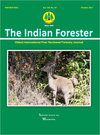Breeding Success and Mortality Rates in the Spot-billed Pelican (Pelecanus philippensis), at Telineelapuram Bird Protected Area, (An Iba Site; in 229) Srikakulam District, Andhra Pradesh, India
DOI:
https://doi.org/10.36808/if/2017/v143i10/119370Keywords:
Breeding, Hatching, Mortality, Nesting, Village Pelicanery.Abstract
Breeding success and mortality rates of migratory birds are mainly depends on the available food resources, safe nesting sites and mortality of chicks. Present study revealed the breeding success and chick mortality in Spot-Billed Pelicans (Pelecanus philippensis), over a period of five years from 2008-2013, undertaken at a pelicanery of village Telineelapuram. The Spot-Billed Pelican (Pelecanus philippensis) is one of the important migratory birds visiting regularly for last 20 years. Overall breeding success during study period is considerable; however year wise statistics are differing. The recruitment percentage had ranged from a low of 24.44% in the year 2010 to a maximum of 47.11% in the year 2012 with an average success rate during five years study is 39.34%. At the same time, the rate of chick mortality was also high at Telineelapuram, due to the influence of different factors (namely Cyclones, Perching activity, Predations and Falling of chicks). The number of dead young birds during different years of the study period had ranged from 33 to 82. Highest mortality (82 individuals) was observed during the year 2010. The average mortality rate of chicks at Telineelapuram is 18.72% and detailed results were projected.References
Birdlife International (2001). Threatened birds of Asia: the Bird Life International Red Data Book. Cambridge, UK: Bird Life International.
GoI, MoEF (2005). Government of India, Ministry of Environment and Forests. Country Report-India: Central Asian Flyway Action Plan for Water birds and their Habitat (CMS/CAF/Inf.4.13 ed.). Delhi: UNEP/CMS.
Gokula V. (2011). Breeding biology of the Spot-billed Pelican (Pelicanus philippensis) in Karaivetti bird sanctuary, Tamil Nadu, India. Chinese Birds, 2(2): 101-108.
IUCN. (2014). IUCN Red List of Threatened Species. Version 2014.1. . Downloaded on 29 June 2014.
Kannan V. and Manakadan R.(2005). The status and distribution of Spot-billed Pelican Pelecanus philippensis in southern India. FORKTAIL, 21:9–14.
Sebastian M.K., Arun P.R., Arthi T., Murugesan M. and Azeez P.A. (2012). WETLANDS OF SRIKAKULAM DISTRICT AN ECOLOGICAL STATUS SURVEY, Final Report, Submitted to the Ministry of Environment and Forests, Government of India by Sálim Ali Centre for Ornithology and Natural History, Coimbatore.
Pai M. (2009). VANISHING SPECIES II Vanishing Species - The Painted Stork, http://mohanpaisarticles.blogspot.in/2009/05/vanishing-speciespaintedstork.html
Murugesan M. (2011). Telineelapuram Bird Sanctuary - A paradise for Spot-billed Pelican and Painted Stork, SACON NEWS, 8(2):1-8.
Nanda Kumar N.V., Nagarjuna A., Reddy D. C., Mallikarjuna Rao C. and Chalapathi Rao P.V. (2011). Management of Nelapattu Bird Sanctuary and Conservation, Paper presented in 3rd International Conference on Climate Change, Forest Resource and Environment (ICCFRE, 2011).
Pathak C.P. (2011). “A Study of Ecology of the Piscivorous Birds at Thol Bird Sancturyâ€, thesis PhD, Saurashtra University.
Sharma P.K. and Raghavaiah P.S. (2002). Effect of Rainfall on Grey Pelican (Pelicanus philippensis) Arriving and Breeding at Nelapattu bird sanctuary, Andhra Pradesh. Indian Forester, 128(10)1101-1105.
Srinivasulu C. (2008). Telineelapuram- A Pelican haven. Biodiversity News of Andhra Pradesh, 2(2 & 3).
Stattersfield A. and Capper D. (2000). Threatened Birds of the World. Birdlife International: Cambridge, UK.
Subramanya S. (2005). Heronries of Tamil Nadu. Indian Birds, 1(6): 126-140.
Urfi A.J. (2011). Climate change and its impacts on Indian birds: monsoon phenology and monitoring heronry birds. Current Science, 101(9): 1140-1142.
Vijayan L., Prasad S.N. and Sheeba N. (2006-2011). Ecology and Conservation of the Spot-billed Pelican in Andhra Pradesh, SACON, Annual Report 2006 - 2011.
www.google.co.in/search?q=telineelapuram+geographical+coordinates&oq=telineelapuram+geographical+coo&gs_l=psyab.1.0.33i21k1j3 3i160k1.218391.240282.0.242767.28.23.0.0.0.0.452.3601.0j15j1j1j1.18.0....0...1.1.64.ps yab..11.11.2122...0j0i67k1j0i30k1.vpjkqm UQRNA
www.google.co.in/search?q=maps&source=lnms&tbm=isch&sa=X&ved=0ahUKEwjw6qyUkMvSAhXJqJQKHfxHC5gQ_AUICSgE&biw=1366& bih=613&dpr=1#tbm=isch&q=maps+of+india&*
Downloads
Downloads
Published
How to Cite
Issue
Section
License
Unless otherwise stated, copyright or similar rights in all materials presented on the site, including graphical images, are owned by Indian Forester.





